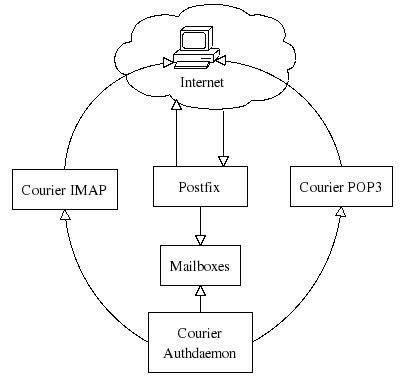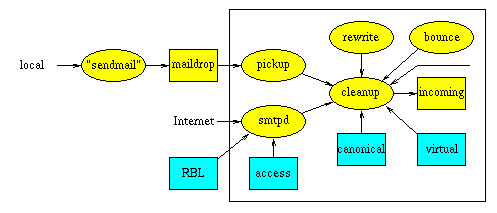PostfixBasicSetupHowto
Postfix 基本设置指南
原文出处:官方wiki
原文作者:
授权许可:
翻译人员:speme
校正人员:
贡献人员:
适用版本: 文章状态:等待翻译
Introduction(简介)
This howto will help you to have a basic Postfix mail server setup for your corporate environment. The main intention of this howto is to teach how you can install and configure a basic Postfix mail server setup with IMAP and POP3 services. I do not intend to tell you how you can integrate advanced stuffs like virus checking and spam filtering with this guide.
这份说明的目标是告诉你如何在企业环境下为Postfix邮件服务器作基本的设置。这份说明的主要目的是教会你进行Postfix邮件服务器的基本配置以使其拥有IMAP与POP3功能。但是,你无法在这份说明中学到在Postfix邮件服务器中集成像病毒过滤及垃圾邮件过滤等高级的功能的方法。
This how to is going to be a kind of more academic howto for staters with Postfix. My advanced postfix guides are PostfixVirtualMailBoxClamSmtpHowto and PostfixCompleteVirtualMailSystemHowto. If you are a newbie to Postfix enjoy them once you have finished this basic howto.
这份说明是针对刚开始使用Postfix的用户提供一个基础的认识。其它的高级指南是Postfix - Postfix 虚拟邮箱和病毒过滤指南以及Postfix - Postfix 完整虚拟邮件系统指南。如果你是一个Postfix的新手,但希望使用那些高级功能的话,你应当事先了解本说明。
Setup Overview(安装提示)
In our setup, Postfix sends & recieves mail from Internet and stores in the user mail boxes while clients in the Internet can retrieve their mails either from Courier IMAP or POP3. The user authentication is done by Courier Authdaemon. The following diagram shows this process.
本指南提供的安装方法,Postfix通过网络来发送及接收邮件并将它们存入用户邮箱中,用户可以通过Courier IMAP 或者 POP3 服务器来回复他们的邮件。用户验证是由 Courier Authdaemon 这个守护进程来完成的。下面的图片表现了这个过程。
Anatomy of Postfix(Postfix的结构)
Components(构件)
The Following figure shows the main Postfix system components, and the main information flows between them.
下面的图片表现了主要的Postfix系统组件,以及它们之间的关键信息流。
- Yellow ellipsoids are mail programs.黄色椭圆是邮件程序。
- Yellow boxes are mail queues or files.黄色方框是邮件队列或文件。
- Blue boxes are lookup tables.蓝色方框是查找表。
- Programs in the large box run under control by the Postfix resident master daemon.在大方框中运行的程序是由Postfix主驻留守护进程控制的。
- Data in the large box is property of the Postfix mail system. 大方框中的数字是Postfix邮件系统的属性。
Receiving Mail(接收邮件)
When a message enters the Postfix mail system, the first stop on the inside is the incoming queue. The figure below shows the main components that are involved with new mail.
当Postfix邮件服务器收到一封新消息的时候,它将首先被放入接收队列中。下面的图表展示了新邮件处理的主要组件。
- Mail is posted locally. The Postfix sendmail program invokes the privileged postdrop program which deposits the message into the maildrop directory, where the message is picked up by the sendmail daemon. This daemon does some sanity checks, in order to protect the rest of the Postfix system.
- 邮件是在本地发送的。Postfix邮件发送程序将首先调用邮件丢弃程序将邮件丢弃到“回收站”目录下,在那里,邮件又将被 邮件发送 进程所处理。这个进程执行一些完整性检查,以保护Postfix邮件服务器的工作。
- Mail comes in via the network. The Postfix SMTP server receives the message and does some sanity checks, in order to protect the rest of the Postfix system.
- 邮件是来自网络的。PostfixSMTP 服务器将接收这些邮件并进行完整性检查,以保护Postfix邮件服务器的工作。
- Mail is generated internally by the Postfix system itself, in order to return undeliverable mail to the sender. The bounce or defer daemon brings the bad news.
- 邮件是由Postfix系统自己生成来返回无法传送的返回邮件给发送者。bounce or defer进程处理该消息。
- Mail is forwarded by the local delivery agent, either via an entry in the system-wide alias database, or via an entry in a per-user .forward file. This is indicated with the unlabeled arrow.
- Mail is generated internally by the Postfix system itself, in order to notify the postmaster of a problem (this path is also indicated with the unlabeled arrow).The Postfix system can be configured to notify the postmaster of SMTP protocol problems, UCE policy violations, and so on.
- The cleanup daemon implements the final processing stage for new mail. It adds missing From: and other message headers, arranges for address rewriting to the standard [email protected] form, and optionally extracts recipient addresses from message headers. The cleanup daemon inserts the result as a single queue file into the incoming queue, and notifies the queue manager of the arrival of new mail. The cleanup daemon can be configured to transform addresses on the basis of canonical and virtua table lookups.
- On request by the cleanup daemon, the trivial-rewrite daemon rewrites addresses to the standard [email protected] form.
Install Postfix
In this setup I assume that your domain is yourdomain.com and it has a valid MX record call mail.yourdomain.com. Remember to replace yourdomain.com with your actual domain in the example codes in this howto. Also I assume that you know what an MX record is. To find out MX your type in a terminal:
dig mx yourdomain.com
To install postfix
sudo apt-get install postfix
Intall mailx package for use as command mail utility program. Mail command is installed with this package.
sudo apt-get install mailx
Test your default setup
Add a user before you start this.
sudo useradd -m -s /bin/bash fmaster sudo passwd fmaster
Test your default installation using the following code segment.
telnet localhost 25
Postfix will prompt like following in the terminal so that you can use to type SMTP commands.
Trying 127.0.0.1... Connected to mail.fossedu.org. Escape character is '^]'. 220 localhost.localdomain ESMTP Postfix (Ubuntu)
Type the following code segment in Postfix's prompt.
ehlo localhost mail from: root@localhost rcpt to: fmaster@localhost data Subjet: My first mail on Postfix Hi, Are you there? regards, Admin . (Type the .[dot] in a new Line and press Enter ) quit
Check the mailbox of fmaster
su - fmaster mail
When your type mail command an output like follows display in your terminal.
Mail version 8.1.2 01/15/2001. Type ? for help. "/var/mail/fmaster": 2 messages 2 new >N 1 root@localhost Mon Mar 6 12:49 13/479 Just a test N 2 root@localhost Mon Mar 6 12:51 15/487 My first mail &
You will observe that mails are indexed by numbers and you can type the number of which the mail that you want to read. For example type no "2" to read the 2nd mail. The type "q" to quit. The mail will be written to a file called mbox in user's home directory. According to our example it will be /home/fmaster/mbox.
All messages in an mbox type of mailbox are concatenated and stored in a single file. The beginning of each message is indicated by a line whose first five characters are "From " and a blank line is appended to the end of each message
Setting Postfix Support for Maildir-style Mailboxes
Maildir is a format for an e-mail spool that does not require file locking to maintain message integrity because the messages are kept in separate files with unique names. A Maildir is a directory (often named Maildir) with three subdirectories named tmp, new, and cur. The subdirectories should all reside on the same filesystem.
Another reason to use Maildir format is that Courier IMAP/POP3 servers only work with Maildir format of mailboxes.
Please find out more about Maildir here
sudo vi /etc/postfix/main.cf
Add the following code segment:
home_mailbox = Maildir/
Comment the Line mailbox_command = procmail -a "$EXTENSION" adding a "#" at the beginning
Restart Postfix to make changes effect.
sudo /etc/init.d/postfix restart
Test your setup again
Installing courier IMAP and POP3
sudo apt-get install courier-pop sudo apt-get install courier-imap
= Adding local domains to postfix
sudo vi /etc/postfix/main.cf
Add your domain to:
sudo vi /etc/postfix/main.cf
Add your domain to mydestination. Once added it should be like the following code segment.
... mydestination = mail.fossedu.org, localhost.localdomain, localhost, yourdoamin.com ...
Add your local network to:
sudo vi /etc/postfix/main.cf
I assume that your local network is 192.168.1.0/24 and add your local network to mynetworks. Once added it should be like the following code segment.
mynetworks = 127.0.0.0/8, 192.168.1.0/24
Make Postfix to receive mail from the Internet
Set inet_interfaces = all in /etc/postfix/main.cf using:
sudo vi /etc/postfix/main.cf
Finally Restart Postfix;
sudo /etc/init.d/postfix restart
Test your setup again using following code:
telnet mail.yourdomain.com 25 ehlo yourdmain.com mail from: [email protected] rcpt to: [email protected] data Subject: My first mail for my domain Hi, Are you there? regards, Admin . (and Enter In a new Line) quit
Check the mailbox of fmaster
su - fmaster cd Maildir/new ls
Now you will see mail has a separate file
Testing Courier POP3
Type in a terminal:
telnet mail.yourdomain.com 110
Use the following example code segment for your test. Be intelligent to tweak the changes appropriately to your environment. An output like follows will display in your terminal.
Connected to mail.yourdomain.com (69.60.109.217). Escape character is '^]'. +OK Hello there.
Type the following code segment in the prompt provided by the Courier POP3 server. I assume that you inetligent enough not to type the lines which starts from +OK
user fmaster +OK Password required. pass password +OK logged in. quit
Testing Courier IMAP
Type in a terminal:
telnet mail.yourdomain.com 143
Use the following example code segment for your test. Be intelligent to tweak the changes appropriately to your environment. An output like follows will display in your terminal.
* OK [CAPABILITY IMAP4rev1 UIDPLUS CHILDREN NAMESPACE THREAD=ORDEREDSUBJECT THREAD=REFERENCES SORT QUOTA IDLE ACL ACL2=UNION STARTTLS XCOURIEROUTBOX=INBOX.Outbox] Courier-IMAP ready. Copyright 1998-2005 Double Precision, Inc. See COPYING for distribution information.
Type the following code segment in the prompt provided by the Courier IMAP server.
a login fmaster password a OK LOGIN Ok. a logout
Local Alias database
When mail is to be delivered locally, the local delivery agent runs each local recipient name through the aliases database. The mapping does not affect addresses in message headers. Local aliases are typically used to implement distribution lists, or to direct mail for standard aliases such as postmaster to real people. The table can also be used to map Firstname.Lastname addresses to login names.
Alias lookups are enabled by default and you will see following code segment in main.cf file.
... alias_maps = hash:/etc/aliases ...
Creating an alias for an account
The following codes illustrate how you can setup an alias. This step is optional since we are going to configure virtual mail domains later in this howto. I have added this step to make understand how you can do this in case of a requirement.
Create a user
sudo useradd -m -s /bin/bash sysadmin sudo passwd sysadmin
Edit the alias table
Open the alias file with:
sudo vi /etc/aliases
Add the following code:
fmaster: sysadmin
To make your changes effect type:
sudo newaliases
To test your changes send a mail to fmaster and check the mail in /home/sysadmin/Maildir/new folder.
Per User .forward Files
Users can control their own mail delivery by specifying destinations in a file called .forward in their home directories. The syntax of these files is the same as with system aliases, except that the lookup key and colon are not present.
I will illustrate an example here:
Assume that you need to for all the mails which comes sysadmin account to an another account do like this
su - sysadmin touch .forward
Then open the .forward file
vi .forward
Add the following code:
[email protected]
Remember to use email address which exists in this exercise.
Now send a mail to sysadmin and mail should come to [email protected]
Postfix virtual Aliases for separate domains and Linux system accounts
With this approach, every hosted domain can have its own info etc. email address. However, it still uses LINUX system accounts for local mailbox deliveries.
With virtual alias domains, each hosted address is aliased to a local UNIX system account or to a remote address. The example below shows how to use this mechanism for the fossedu.org and linuxelabs.com domains.
Open the main.cf file:
sudo vi /etc/postfix/main.cf
Add the following code segment:
virtual_alias_domains = fossedu.org linuxelabs.com virtual_alias_maps = hash:/etc/postfix/virtual
Edit the /etc/postfix/virtual file:
Add two Linux system accounts
sudo useradd -m -s /bin/bash sigiri sudo useradd -m -s /bin/bash kala
Set Password for the above users.
sudo passwd sigiri sudo passwd kala
sudo vi /etc/postfix/virtual
Add the following code segment:
[email protected] sigiri [email protected] kala
To create a Map Database type :
sudo postmap /etc/postfix/virtual
The postmap is utility program that will convert /etc/postfix/virtual to /etc/postfix/virtual.db Berkley DB format, so that Postfix can access the data faster.
Restart Postfix to make changes effect:
sudo /etc/init.d/postfix restart
Send mails to both [email protected] and [email protected] and those mails should come to mailboxes of sigiri and kala respectively.


